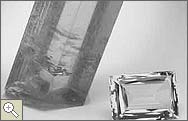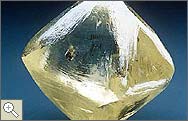
Gems: The Chosen Few
Gems are mineral crystals that have been cut and polished. Jewelers, for example, may select certain crystals to cut into gems because of their extraordinary color, but select others such as diamonds for their hardness and flashes of color (known as "fire"). In general, any attractive, relatively flawless crystal can be cut into a gem. Although almost any of the four thousand kinds of minerals could be cut into a gemstone, in practice most gems used in jewelry today come from only about fifteen different minerals.
Size, beauty, rarity, and durability are the basic criteria that determine a gem's value, though a rich and interesting history can add to that worth. Because of their beauty and the skill and artistry necessary to cut gemstones from crystals, gems have always been expensive. For centuries, gems belonged almost exclusively to royalty. One factor in the value of a gem is its weight. Gem weight is measured in carats; one metric carat equals 0.2 grams (.007 ounces). The word carat comes from carob, a Mediterranean tree whose seed was for centuries the standard for weighing precious stones.
In the Smithsonian collection, the largest cut diamond is the Portuguese Diamond, weighing an astonishing 127.01 carats (just under one ounce)! The Oppenheimer Diamond at 253.7 carats is one of the largest uncut diamonds known to exist (since the Oppenheimer Diamond is not cut, it is not a gem). The most famous diamond of them all, the deep blue Hope Diamond (45.52 carats), is surrounded by sixteen white diamonds and suspended from a platinum chain bearing forty-six more diamonds. Although visitors may appreciate only its size and craftsmanship when they look through the display case, in fact they are looking back in history at a formation process that occurred more than a billion years ago.
|
 |
 |
 |
 |

Aquamarine © Smithsonian Institution
|
 |
 |

The uncut aquamarine crystal on the left is
15,256 carats. A similar crystal was cut into the
1,000-carat gem beside it.
|
 |
 |
 |
 |
 |
 |

Oppenheimer Diamond © Smithsonian Institution
|
 |
 |

The Oppenheimer Diamond is one of the largest uncut diamonds in the world
|
 |
 |
 |
|

